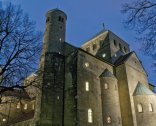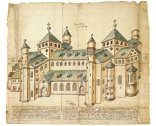St. Michael’s Basilica at Hildesheim
The church of St. Michael’s Benedictine monastery in Hildesheim is the epitome of Ottonic architecture and the advanced development of the architectural concept of the collegiate church at Gernrode (after 959 AD). Bishop Bernward is named as the builder and founder of the three-nave basilica with two choirs and two symmetrical cross-aisles of equal size.
The square of the intersection of the nave and the transept form the basic unit of all the dimensions used in the structure. Each bay in the nave is limited by four square columns and accompanied by two slender columns concamerated by arches in the longitudinal direction.
The transition from column to arch is formed by a block capital. In the floor plan, the center aisle consists of three squares. Three-storey galleries form the termination of the transepts. The principle of the bound system is obvious and is the reason for the internal peace and clarity. Two square, compact towers rise above the crossings. Four lofty stair towers are positioned at the extremities of the cross-aisles.
Three apses form the eastern chancel termination, whereby the chancel and the apse at the western end, being in an elevated position, accommodate the crypts that can be viewed underneath. Today, little remains to be seen of the former lavishly decorated ornamental forms of the Byzantine era and late antiquity. The painted ceiling with Jesus’ family tree, going back to Bishop Adelog in 1180, was, thanks to its timely evacuation, saved from being destroyed during World War II.
The church building suffered severe damage, but every effort has been made since to restore it to its former glory. next site ...
